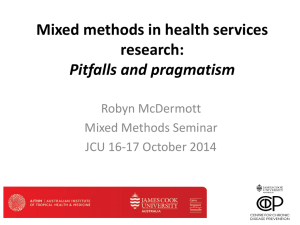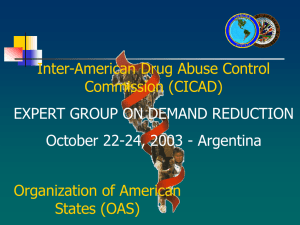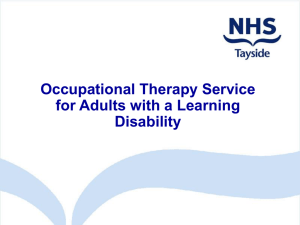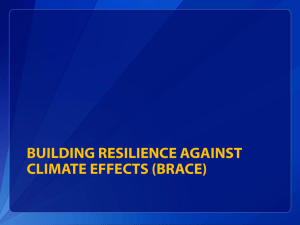Components of national prevention system ENG
advertisement
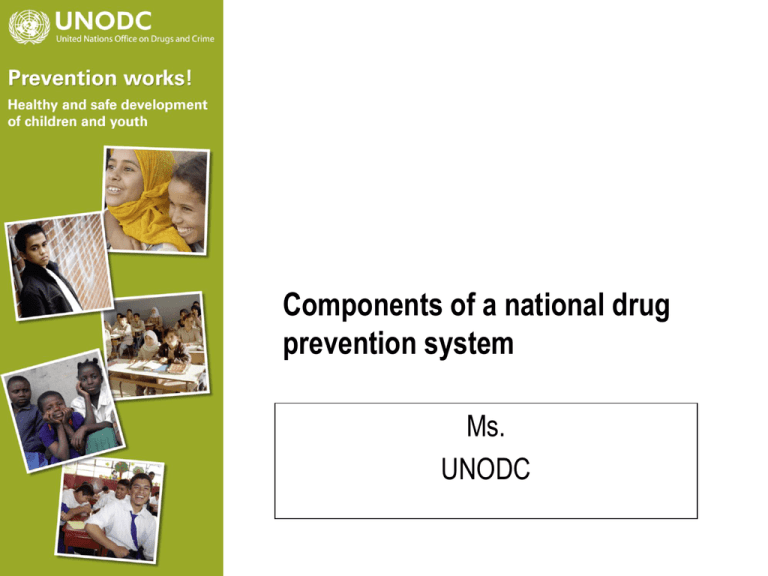
Components of a national drug prevention system Ms. UNODC National drug prevention system 1. Strong delivery infrastructure as one of the critical components of a national drug prevention system 1. Strong delivery infrastructure as one of the critical components of a national drug prevention system Prevention as part of health centered drug control framework Support by other health, education and social policies Supportive regulatory frameworks – Some examples • Skills based education included in the national school curriculum and in the teacher training system. • Mandating schools and workplaces to implement participatory and supportive substance abuse prevention policies. • Offering pre-natal care with psycho-social services to families at risk. • Reducing access of youth to licit substances National standards for drug and substance abuse prevention • setting the minimum standards for interventions and policies • national professional standards for drug and substance prevention practitioners, setting the minimum competencies and skills • - … setting the stage for the > training of practitioners > training of decision makers > training of researchers Resources and ongoing training • Trained policy makers, practitioners, researchers. – Ongoing training – Professionalisation • Adequate financial resources Sustainability • Medium – long term prevention strategies with resources. • Mechanism foreseen for review at regular intervals on the basis of data and evidence. • Training is provided on an ongoing and regular basis to maintain professional capacity. http://www.cicad.oas.org/ main/pubs/ How_to_Develop_a_National_Drug_Policy_CICAD-CARICOM.pdf http://www.cicad.oas.org/ http://www.emcdda.europa.eu Prevention Hub by Mentor International www.preventionhub.org Task in national groups • Please go through your national plan for improvement. • Is there anything that you need to add so that interventions and policies are supported by a strong delivery structure? • It could be a new objective – For example, national standards for drug prevention interventions and policies developed and adopted. • It could be activities under existing objectives – For example, if you want to develop prevention education in schools, you might want to add the adoption of a relevant regulation. – If you want to implement a new intervention or expand an existing one, have you foreseen sufficient training? • What about sustainability? National drug prevention system 2. A range of stakeholders involved in planning and delivery as one of the critical components of a national drug prevention system A range of stakeholder at different levels and from different kinds of institutions and sectors (1/2) A range of stakeholder at different levels and from different kinds of institutions and sectors (2/2) Multiple sectors, levels, institutions • • • • Strong coordination Integration horizontally and vertically Clear roles and responsibility Stages of the project cycle – – – – Planning Delivery Monitoring Evaluation Sustainability • Integration and coordination – It is sustainable? – Could it be streamlined? • Mechanisms for integration and coordination at regular times Task in national groups • Please go through your national plan for improvement. • Is there anything that you need to add so that interventions and policies are supported by a range of stakeholders? • Do you need a new objectives or new activities? • What about sustainability? 3. Scientific evidence and research as one of the critical components of a national drug prevention system Implementation of strategies based on scientific evidence, data and evaluation Data collection system (1/2) • Epidemiology – Who is using? – Initiation age, transition to disorders, drugs used, patterns of use, risk groups. • Influences - Why are they using? – Vulnerabilities and protective factors • Consequences – Use and dependence related harm and costs (e.g. mortality, crime, HIV, foster care...) Data collection systems (2/2) • Utilizing multiple different data-sources – Registers in substance abuse treatment, health care, juvenile and law-enforcement systems, social welfare, etc. – Local and national surveys • Collecting data at regular intervals • Feeding the data to the planning and development of prevention systems Utilizing evidence based strategies (1/2) • Theory-based – Scientific understanding of the vulnerabilities addressed – Scientific theories on behaviour change • Monitoring – Monitoring of implementation fidelity and reach • Evaluation of effectiveness – – – – Quasi-experimental or experimental Collaboration with research institutions Intermediate outcomes (mediators) (Long-term) outcomes (substance use) • Consulting existing standards – EMCDDA! Example of quality standards for the planning, implementation, monitoring and evaluation of prevention programmes Utilizing evidence based strategies (2/2) • Utilising programmes that have evidence of effectiveness from elsewhere – Systematic process for adaptation – Minimal adaptation first with monitoring of fidelity and scientific evaluation – Possible deeper theory-based adaptation later – Involve research institution/ university and possibly the developer Example of compilation of evidence-based programmes to choose from More in-depth discussion of adaptation Other examples from the Canadian Centre on Substance Abuse - www.ccsa.ca Task in national groups (1/2) • Please go through your national plan for improvement. • Is there anything that you need to add so that interventions and policies are supported by scientific evidence and research? • Do you need a new objectives or new activities? • What about sustainability? Finally … Task in national groups (2/2) • Please go through your national plan for improvement. • Is your plan really complete? – All ages …. Hopefully yes! What about critical transition periods? – All relevant settings – All risk groups – All risk levels (universal, selective, indicated) • Anything you might want to add or prioritize at this stage?
